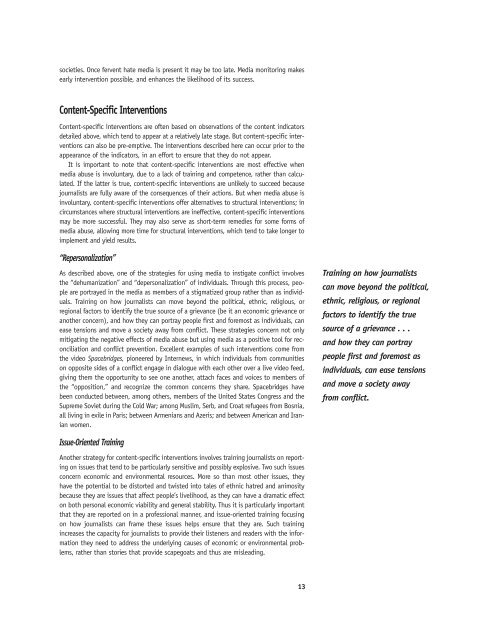Institutional Racism
Institutional Racism
Institutional Racism
You also want an ePaper? Increase the reach of your titles
YUMPU automatically turns print PDFs into web optimized ePapers that Google loves.
societies. Once fervent hate media is present it may be too late. Media monitoring makes<br />
early intervention possible, and enhances the likelihood of its success.<br />
Content-Specific Interventions<br />
Content-specific interventions are often based on observations of the content indicators<br />
detailed above, which tend to appear at a relatively late stage. But content-specific interventions<br />
can also be pre-emptive. The interventions described here can occur prior to the<br />
appearance of the indicators, in an effort to ensure that they do not appear.<br />
It is important to note that content-specific interventions are most effective when<br />
media abuse is involuntary, due to a lack of training and competence, rather than calculated.<br />
If the latter is true, content-specific interventions are unlikely to succeed because<br />
journalists are fully aware of the consequences of their actions. But when media abuse is<br />
involuntary, content-specific interventions offer alternatives to structural interventions; in<br />
circumstances where structural interventions are ineffective, content-specific interventions<br />
may be more successful. They may also serve as short-term remedies for some forms of<br />
media abuse, allowing more time for structural interventions, which tend to take longer to<br />
implement and yield results.<br />
“Repersonalization”<br />
As described above, one of the strategies for using media to instigate conflict involves<br />
the “dehumanization” and “depersonalization” of individuals. Through this process, people<br />
are portrayed in the media as members of a stigmatized group rather than as individuals.<br />
Training on how journalists can move beyond the political, ethnic, religious, or<br />
regional factors to identify the true source of a grievance (be it an economic grievance or<br />
another concern), and how they can portray people first and foremost as individuals, can<br />
ease tensions and move a society away from conflict. These strategies concern not only<br />
mitigating the negative effects of media abuse but using media as a positive tool for reconciliation<br />
and conflict prevention. Excellent examples of such interventions come from<br />
the video Spacebridges, pioneered by Internews, in which individuals from communities<br />
on opposite sides of a conflict engage in dialogue with each other over a live video feed,<br />
giving them the opportunity to see one another, attach faces and voices to members of<br />
the “opposition,” and recognize the common concerns they share. Spacebridges have<br />
been conducted between, among others, members of the United States Congress and the<br />
Supreme Soviet during the Cold War; among Muslim, Serb, and Croat refugees from Bosnia,<br />
all living in exile in Paris; between Armenians and Azeris; and between American and Iranian<br />
women.<br />
Training on how journalists<br />
can move beyond the political,<br />
ethnic, religious, or regional<br />
factors to identify the true<br />
source of a grievance . . .<br />
and how they can portray<br />
people first and foremost as<br />
individuals, can ease tensions<br />
and move a society away<br />
from conflict.<br />
Issue-Oriented Training<br />
Another strategy for content-specific interventions involves training journalists on reporting<br />
on issues that tend to be particularly sensitive and possibly explosive. Two such issues<br />
concern economic and environmental resources. More so than most other issues, they<br />
have the potential to be distorted and twisted into tales of ethnic hatred and animosity<br />
because they are issues that affect people’s livelihood, as they can have a dramatic effect<br />
on both personal economic viability and general stability. Thus it is particularly important<br />
that they are reported on in a professional manner, and issue-oriented training focusing<br />
on how journalists can frame these issues helps ensure that they are. Such training<br />
increases the capacity for journalists to provide their listeners and readers with the information<br />
they need to address the underlying causes of economic or environmental problems,<br />
rather than stories that provide scapegoats and thus are misleading.<br />
13

















